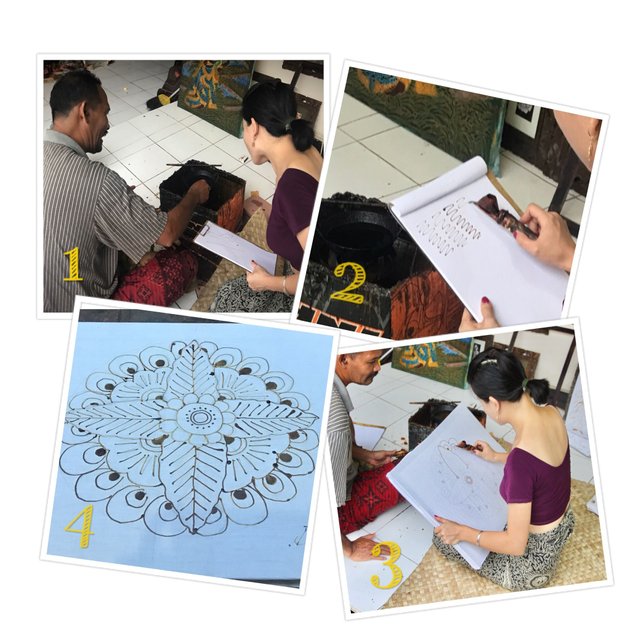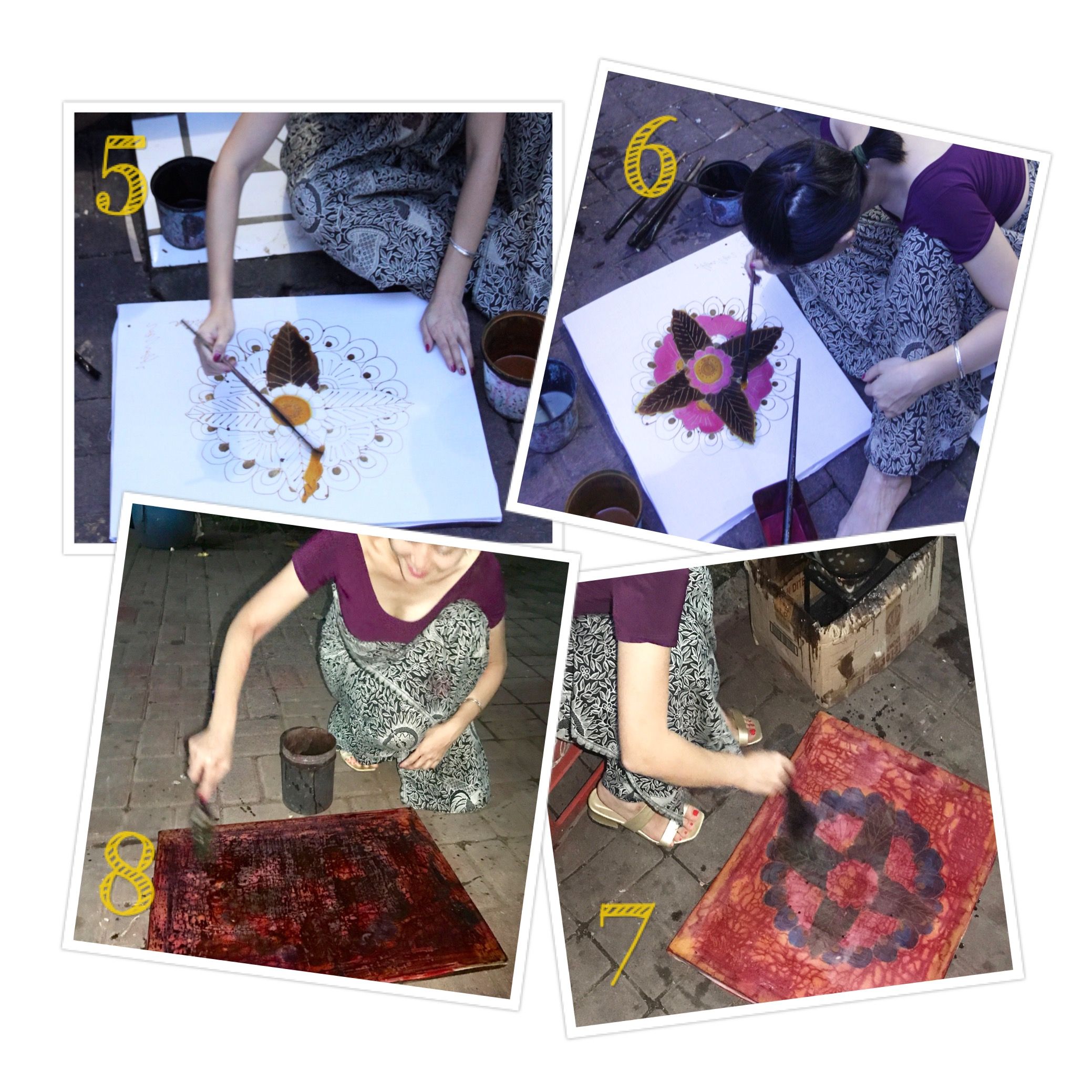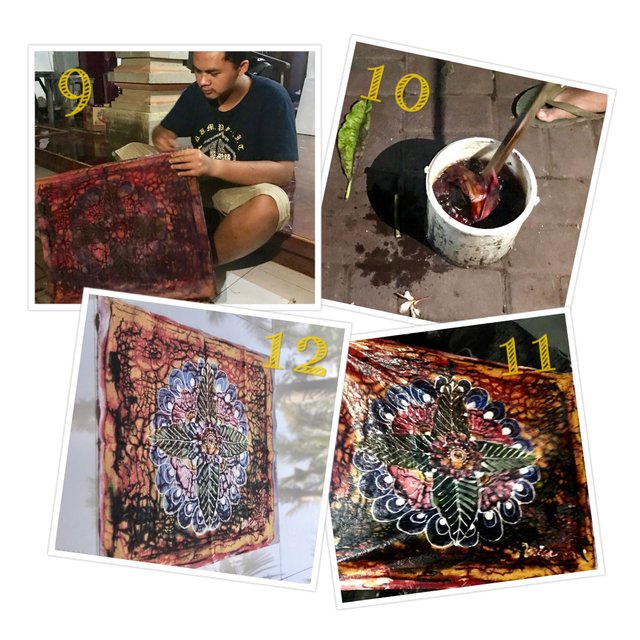#66 Batik Stories (1) - My First Batik Work/Failure in Indonesia 蜡染系列(一)我的蜡染处女作
So What Is Batik?
The term batik originates from the Javanese/Malay words "amba" and "titik" meaning to draw and to dot. Wax is used to block dye from penetrating the fabric, leaving unwaxed areas to the original colour to make design patterns. You can repeat the process of wax resisting and dyeing, to create elaborate multicoltred designs.
In my travels, I've seen batik fabric frequently in Southeast Asia and South Asia, as well as in some ethnic minority villages in Guizhou province in southwest China. And in my cross-culture training work I once learned that, batik textiles have also existed for centuries in many parts of Africa, for example, the people in Yoruba tribe in Nigeria use cassava for resist dyeing while the people of Senegal use rice paste.
The batik cloths are in the form of sarongs, scarves, dresses, shirts, bags, mats, coasters, tablecloths, curtains, bed sheets and are used to frame pictures or are framed as an artwork to decorate the wall. And you can be creative to apply it to more items, for instance, I’m thinking of making some jewelry out of it, such as necklaces, bracelets, rings and earrings.
In this Batik Series, I’d like to talk about my encounters and experiences with batik in different countries. First, I will share with you my batik making in Indonesia, though the result turned out to be quite different than I imagined ;p.
My Batik Making in Bali
Last year I joined a batik making workshop in Bali, Indonesia, and learnt some interesting lessons about batik, this intricate technique on fabric.
去年在印尼的巴厘岛参加了蜡染的手工作坊,粗浅地感受了其中一种蜡染的制作工艺,所以这篇文章打算带大家探索一下蜡染的奥妙。
那么什么是蜡染呢?实际上完整的叫法应该是“用蜡防止染色”,就是通过在布料上用热蜡勾勒出点和线,或者用刷子大面积刷上蜡,以隔断染料来保留布料原色,等蜡被除去之后,和被染色的部分一起呈现出各种花纹。只要不断重复上蜡染色的过程,就可以染出越来越精美复杂的图案。
据史书记载,靛蓝的还原技术在春秋战国时期已开始使用,而且一直沿用至今。秦汉、六朝时期蜡染工艺逐渐流行起来,到隋唐时期达到高峰。自宋代开始衰退,而同一时期在印度洋上的爪哇、苏门答腊等岛却十分盛行。这些地区的蜡染经过长期发展,如今已经成为世界范围内知名的最为系统全面的工艺。
印度尼西亚的蜡染工艺在2009年10月2日被联合国教科文组织纳入人类非物质文化遗产,印尼人也由此将10月2日定为全国巴迪克(batik)日。蜡染服装巴迪克在印尼被尊为“国服”, 印尼人在各传统,正式的场合普遍穿着巴迪克。在东南亚和南亚旅行的时候, 特别是在印尼和马来的一些村落里,经常看到人们穿着蜡染布料的衬衫和裹裙。
这次我在印尼参加的蜡染手工作坊,是由巴厘岛小有名气的一位民间蜡染艺人在自家院子里主持教授的,这位师傅从小对绘画很感兴趣,由于家境不宽裕,早早开始靠卖画卖蜡染布料为生。他家院子里挂满他的绘画和蜡染作品,画面上栩栩如生的动植物,宗教祭祀细节,乡间的农耕场景, 无不洋溢着浓郁的民族风情。
师傅告诉我最初的蜡染是在棉,麻布料上绘制图案,后来渐渐出现蚕丝、人造丝、聚酯纤维等面料。印尼蜡染的传统花色多为深浅搭配的大地色系,随着长期的技术发展和文化融合,颜色、样式、图案都逐渐多样化。传统的蜡染工艺精美繁复,但是耗时费力,价格不菲。所以近年来出现大批机制蜡染布,价格相对实惠,但自然没有手工制品那么高的艺术价值。
蜡染绘画的创作离不开蜡:蜡质的配置,蜡温的调控,还有施蜡的手法等因素,都会对画作产生影响。蜡的品类繁多,熔点也各不相同。师傅说在印尼,他们通常选用蜂蜡和石蜡作为防染的主体材料,蜂蜡和石蜡以不同比例,调制成软硬程度各异的蜡质。有些地区会添加松香、米浆、树脂、油脂等来调整材料。

1 - Heating wax
2 - Practicing drawing with batik pen/canting on paper
3 - Drawing a Mandala pattern with wax on the cotton canvas
4 - Finished wax Mandala
师傅一边解释一边嘱咐他儿子加热容器里的蜡,同时指导我先用铅笔勾画轮廓。因为是第一次学习蜡染,师傅提议我画个比较简单的曼陀罗(Mandala)图案,这在梵语里意思是神圣的圆轮或中心。曼陀罗图案常见于东方的印度教和藏传佛教的建筑和装饰中,在西方和拉美的书店里、地摊上也常出售各种曼陀罗图案的涂色本供人练习绘画。瑞士心理学家荣格曾研究引用曼陀罗所呈现的宇宙奥秘和个人内心潜能的联系,将其运用在心理学领域,介绍给西方人。
我们把棉布固定在木框上,然后用铅笔在棉布上打底,我从小喜欢涂涂画画有点基础,很快就在师傅的指导下勾画出曼陀罗的图案,可是接下来的上蜡就没那么容易啦。热蜡容易冷却凝固,而铜制的画刀便于保温,所以要用铜蜡刀来作画。技术熟练的艺人像这位老师傅大都是不用打底,直接用蜡刀在布面上作画。
为了避免我这个新手用蜡无情地摧毁画面,师傅递给我一本白纸,教导我先老老实实在白纸上练习使用铜蜡刀。这确实是项技术活,先用蜡刀从容器里舀装已烧热熔化的液体蜡,勾画时要尽量和纸面保持平行,停止时让笔头朝上以免液体蜡过多地流向纸面,初学者容易犯的错误就是像使用一般铅笔水笔一样,停笔时笔头朝下,这样液体蜡就会涌向纸面,导致过度蜡汁积聚在同一处,影响线条的流畅度。所以呢,当你看到一张画布上的线条被星星点点的蜡中断,肯定是出自新手,比如我😄。
估计是为了保持我创作的热情,师傅还不断鼓励我说画得不错,只出现少量积蜡点,在第一次尝试的学徒里算很不错的了。然后每当我暗自得意之时,就立马出现更多蜡点甚至蜡团,看来真是时刻都要集中注意力在刀尖啊。事实证明经验丰富的师傅太有先见之明了,看着面前纸上断断续续的黄蜡,好庆幸我没有直接用铜蜡刀在棉布上作画。经过几张白纸上的蜡刀描绘练习,我开始移师布面了。

5 & 6 - Coloring with natural dyes made from plants
7 - Brushing paraffin onto the surface after applying hydrochloric acid, paraffin, cracking and red dye
8 - Dyeing the fabric in black after cracking
(I was so excited and did too much cracking ;), and I won’t use red and black dyes if I have a second chance in future, as I feel these dark cracks overshadowed the Mandala.)
首先要不断去舀热蜡,用蜡勾勒完线条便开始涂色。这里用的染料都是天然植物制成。值得注意的是,这里涂上的颜色并不是布料最终的颜色,因为刷上盐酸和蜡后还会变色。这些真理其实是我后来才领悟到的,到最后看到成品的颜色才后悔莫及...... 因为师傅带着浓重口音的有限英语实在很难交流,而我当然也不会当地话,所以只能被动接受指示。
我上完颜色后,给正反面刷几遍盐酸来固色,刷时看到圆圈内的白色变成湖蓝色,我顿觉不妙,怎么颜色变成这样了,始料未及啊。师傅看我动作放缓,就自己去用大刷子蘸水狂刷了一通。 然后指导我刷石蜡,用手掰出裂纹。接着刷红色染料,继续重复刷石蜡,做裂纹,最后刷一遍黑色染料。有点后悔听从师傅用红黑染料的指示,而且因为我第一次操作蜡染,太过兴奋,掰出过度裂纹,导致最后弄出颜色和纹理十分可怕的成品,跟我想象中的清新淡雅的花布完全不同。
师傅的儿子帮忙拆下木框后,我们把刷过蜡和红黑染料的饱经摧残的画布浸入温水以熔化蜡 ,反复漂洗几遍,使残留的黄蜡脱净,最后将湿布晒干,就大功告成啦。
下图12这块布料就是颜色可怖裂纹过度的成品,还请大家不要嫌弃,凑合着看看吧。:D 如果不是亲手做出来的,我真恨不得扔掉啊,太碍眼了。好笑的是,师傅还一个劲儿地夸赞这颜色组合很好,哈哈,好吧,难道这还是印尼审美中的精品?可爱的读者们,你们觉得呢?

09 - Removing canvas from frame
10 - Melting wax of the fabric in warm water
11 - Take the fabric out after all the wax is gone
12 - Dry it in the sun ☀️
The end product turned out to be pretty deep in color, and too much cracking had been done. This is different than the neat result I imagined earlier when painting. A lesson learnt... ;) w(゚Д゚)w
So what do you think of my first batik work? Have you ever tried making something but it turned out to be different than you thought? Tell me your experience in the comments! :D See you next time!
Thank you for reading. Check out my recent posts, and follow me for more! =)
Street Art & Sultan Mosque in Singapore 新加坡苏丹回教堂和附近的涂鸦艺术
A Mongolian Poppy, Opium, and Terelj National Park 蒙古的野罂粟&鸦片&特勒吉国家公园
Let's Cook Braised Pork with Tofu and Shiitake 一起做香菇豆腐红烧肉
The Busker and His Soulmate 街头知音
Train Cemetery in the Atacama Desert (1) 大漠中的火车墓场(一)
Some “Framed” Photos from My Travels 自带边框的旅途剪影
The Star Bridge - Stari Most in Bosnia 波黑的明星老桥
Satay Fried Rice Recipe 简单美味的沙爹炒饭
Some SMILE Portraits in My Travels 旅途中的微笑
Zodiac Animals Workshop in Australia 澳洲孩子的生肖灯手工作坊
Stories of Shadows (2@Europe + 2@South America) 光影交错的瞬间
About Chinese New Year + My Greeting Cards 我做的春节贺卡~祝大家狗年大吉
Follow Me to Grey Glacier (2) 格雷冰川初探(二)

Here are some screenshots from my Instagram. Follow @ItchyfeetDonica for more shots around the globe !

!steemitworldmap -8.509944 lat 115.264935 long Ubud, Bali d3scr
That's the coolest!!! Perfect timing! I just got to Bali last night 3 am!
Awesome! Look forward to your fresh stories! I stayed there over 1 month last year, so if you need any tips, feel free to ask. =)
Where did you spend most of your time? Did you go to Ubud or Canggu?
I saw Batik in Thailand, but they used indigo. I love how it's different in different parts of the world. I don't think your end product looks horrible!
I started from the south and stayed in a few different parts all the way to the north. Most of the time I was in Ubud, as you have the most choices of activities there. I stayed in Canggu a few nights too, lots of people went there for surfing. I loved the mountains in the north a lot but there were not so many choices of accommodation there. Where are you now? Enjoy your trip!
这个巴迪克曼陀罗画的很有意境~
谢谢你总是关注支持哦 :)
这么好的帖,我不关注支持对不起自己 :D
The uniform for Malaysia and Singapore Airlines are also based upon batik prints!
Cool patterns right? I bought one in Singapore! :D
Yep, it's a very cool design and a great souvenir to bring back home.
Hello and congratulations on winning a monthly round of my 7 World's Continents Photo Challenge! Enjoy your winning price of 40 SBD. Kindly see to attend your winner announcement post to answer some of the congratulations comments on your winner announcement post. Tomas
Price of 40 SBD/100 USD: 7 World's Continents Photo Challenge - MONTHLY WINNER ANNOUNCEMENT - February 2018!
Yaaay! :D Thank you Tomas! I really appreciate the support of you and other voters.
挺好看的,有东方神秘感LOL
😂 谢谢亲的安慰
想看看更具体的过程🤓🤓🤓
刚加了几张照片说明 所有当天照片都挖出来了 😄 因为是自己参与没法好好拍过程
觉得没写够 还有些其他地方的蜡染照片 估计会有续集
不错啊!这都是独一无二的艺术品。
谢小哥夸奖 嗯 虽然颜色可怕 确实独一无二 😄
最后那张是你的成品嘛?太棒了!!
是呀 谢谢亲夸奖 图案还好 没有料到颜色和裂纹会那么可怕 哈哈
❤ Hola estoy aqui para saludar, para seguirte y para invitarte a ver mi trabajo, señalando ❤ que realizo dibujo ❤ digital y si quisieras uno en especial puedes ❤ contar conmigo, ya que es lo que me gusta hacer ❤
❤ ❤ ❤ ❤ ❤ ❤ ❤ ❤ ❤ ❤ ❤ ❤ ❤ ❤ ❤ ❤ ❤ ❤ ❤ ❤ ❤ ❤ ❤ ❤
Easy there. Tantos corazones, jaja...
很有地域特色!感觉做的非常细致,也要很有耐心。国内西南地区也有蜡染手艺,以前还看过一期这个节目,哪个民族的我倒忘了。
对 我是先在国内看到的 苗族、瑶族、布依等都有 我本来写了 后来删了打算放在续集里 要不一次内容太多 =)